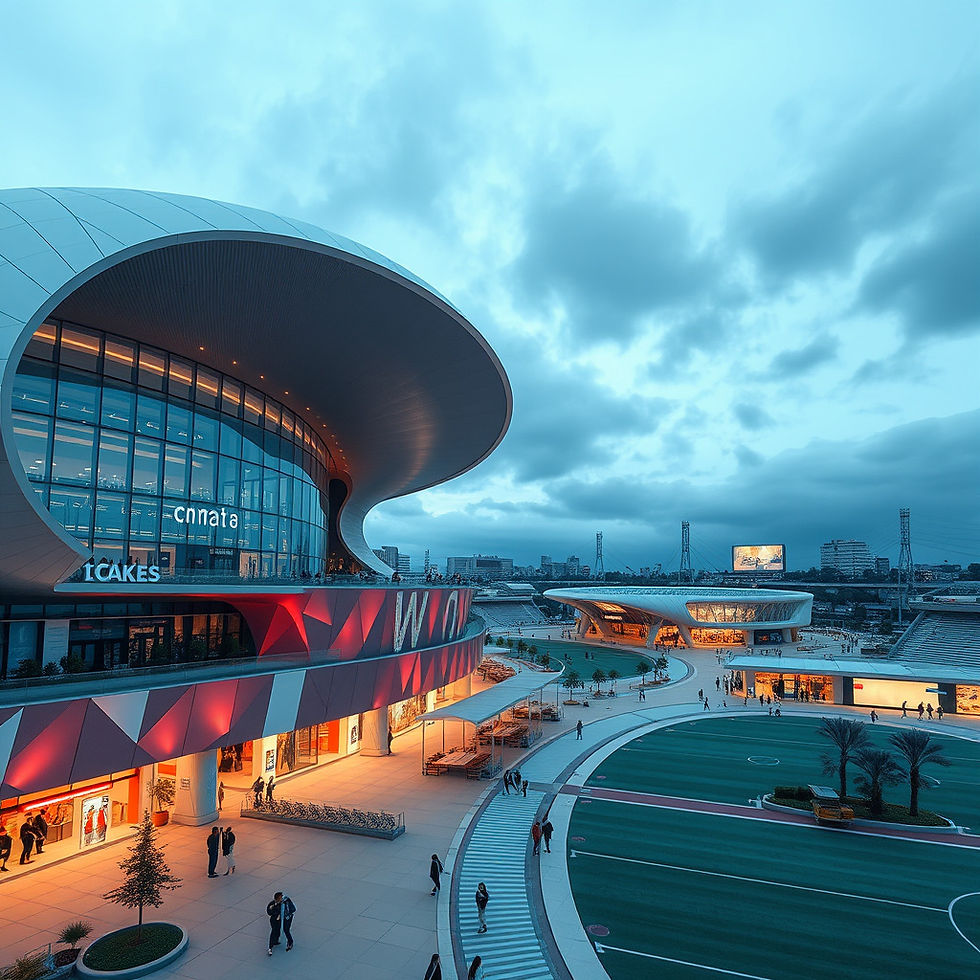Re-imagining Stadium Economics: Designing Multi-Use, Multi-Revenue Venues for the Future
- StratPlanTeam

- Aug 2
- 4 min read

Multi-use stadium design to lock in sustainable economic benefits
Stadiums are no longer just places to watch sport. Around the world, the most successful and sustainable venues are being transformed into vibrant hubs that serve their communities every day, not just on matchdays. In the face of rising costs, changing fan expectations, and shifting urban priorities, the future of stadiums lies in innovation, multi-functionality, and mixed-use integration.
A New Model for Modern Stadiums
The traditional approach to stadium design has largely revolved around the needs of sports teams and fans. However, with average stadium usage rates as low as 3-5% of the calendar year, there's growing pressure to reimagine what a stadium can and should be. The new generation of stadiums must act as catalysts for year-round activity and revenue — seamlessly blending sport, entertainment, culture, commerce, education, and transport.
Modern stadiums are becoming micro-cities — places where fans, families, tourists, and locals can gather for everything from concerts to conferences, from shopping to studying. In this shift, innovation is key — not only in technology but also in how spaces are designed, programmed, and connected to the wider urban fabric.

Mixed-Use Design: Embedding Diversity into Stadium Infrastructure
Innovation in stadium economics starts with masterplanning. Leading venues are being developed with mixed-use at their core, combining residential, retail, hospitality, and office spaces alongside traditional sporting facilities. Stadiums are being reimagined as transport hubs, entertainment complexes, food and beverage destinations, tourist attractions, and even educational campuses.
From incorporating shopping centres and cinemas to embedding hotels, housing, and schools, the most ambitious projects are designed to unlock value far beyond ticket sales. The integration of mass transit, cycle routes, and pedestrian networks ensures ease of access, helping venues become more inclusive and sustainable.

Learning from Global Leaders in Stadium Innovation
In France, the Stade Pierre-Mauroy has taken versatility to the next level. With its moveable pitch, retractable roof, and multipurpose lower bowl, it can seamlessly transition from a 50,000-seat football stadium to a 30,000-seat indoor arena, hosting everything from tennis to concerts.
The Estadio de Futbol Monterrey in Mexico integrates harmoniously with its natural surroundings. Designed with green principles, it features rainwater harvesting, native landscaping, and breathable architectural facades that reduce environmental impact while enhancing the fan experience.
Baku National Stadium, built on a fast-track schedule, used cutting-edge Building Information Modelling (BIM) to deliver a 68,000-seat venue in just 24 months. This data-driven approach highlights how modern technologies can support faster, smarter, and more sustainable stadium construction.
The Nassau Coliseum in New York is noted as an example of how to revitalise a dated venue through smart redevelopment. With no core tenant, the venue is planned as a flexible, community-driven entertainment space, drawing inspiration from London’s The O2 — itself a benchmark for repurposing venues as lifestyle destinations.

Sustainability as an Innovation Driver
Green design isn’t just good for the planet — it makes business sense. Estadio Castelão in Brazil showcases how environmental efficiency can be embedded into the core of a stadium. With significant reductions in water and energy usage and a cutting-edge vacuum sanitation system, it stands as a model of sustainable redevelopment.
The M Chinnaswamy Stadium in Bengaluru is also leading the way with its rooftop solar power plant. Not only does it reduce emissions and energy bills, but it also sets a precedent for renewable energy integration in emerging markets.
Digital Connectivity and Fan-Centric Design
At the heart of modern stadiums is the fan experience — and this increasingly means digital infrastructure. San Francisco’s AT&T Park offers one of the most connected environments in global sport, with over 1,300 Wi-Fi hotspots and a 1-gigabit connection shared across the stadium. High-speed data allows for immersive, personalised experiences that extend far beyond the physical seat.
The Need for Year-Round Relevance
The smartest stadiums drive engagement 365 days a year. Ericsson Globe in Stockholm isn’t just a sports venue — it’s a tourist destination, complete with a glass gondola that takes visitors to the top of the building. Indianapolis Motor Speedway, the world’s largest sporting venue by capacity, is undergoing upgrades to add premium, club-style seating and increase usage through more diverse programming.
Even smaller stadiums like the Borisov Arena in Belarus are showing how intelligent design can maximise limited space and budget. With integrated restaurants, gyms, and public areas, the venue proves that high-spec functionality doesn’t require massive investment.

The Stadium of the Future
As cities grow and change, stadiums must evolve too. Their economic success depends not only on what happens during a game but on how they serve their communities throughout the year. This means building in flexibility, promoting sustainability, and embedding mixed-use functions from the start.
Whether it’s through adaptive architecture, eco-conscious operations, or seamless digital integration, the most successful venues are those that innovate in every sense. By thinking beyond sport, stadiums can become inclusive, multi-use hubs that support jobs, drive tourism, enrich culture, and create enduring economic value.
The next wave of stadium innovation won’t just be measured in capacity or carbon savings — but in how well these venues work as living, breathing parts of the cities they serve.






Comments